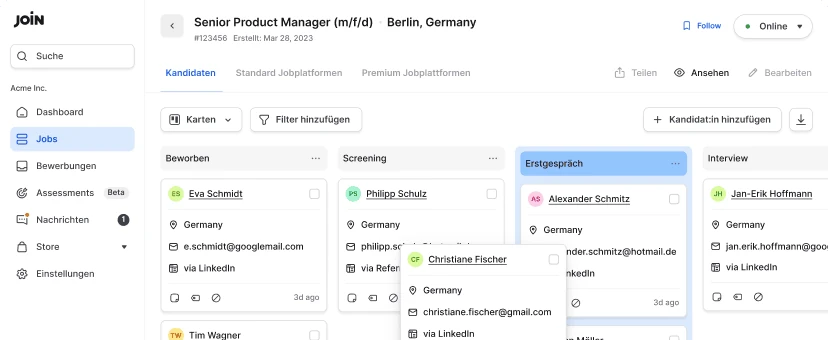How to screen resumes both fast & effectively
Hiring the right candidate is crucial for the success and growth of any business. To ensure that you find the best talent for your open positions, it’s essential to have an effective resume screening process in place.
Does your resume screening take too long? Or do you want to find out how to screen resumes equally and fairly, so that all applicants receive the same attention and treatment?
Perhaps you’re simply not sure yet how to screen a resume. That is, what steps are actually involved in the screening process?
Learning how to screen resumes (or CVs) helps you solve these issues. It lets you separate the wheat from the chaff faster and more efficiently. So below, we’ll walk you through the step-by-step process of both manually screening resumes and using resume screening tools.
We’ll also provide additional tips and best practices to help you make better-informed hiring decisions. Here’s what’s included:
Table of contents
What is resume screening?
Resume screening is the process of reviewing the resumes of job applicants to select the most suitable candidates and reject unqualified or unsuitable applicants. It is part of the wider screening process.
Recruiters will assess an applicant’s skills, qualifications, and experience based on the information in their resume.
If it aligns with the role the recruiter is hiring for, they will move the applicant to the next step in their hiring process. This is generally the start of the interview process.
If the applicant isn’t suitable for the role (or other applicants seem a better fit), the recruiter will reject the application. This is generally done by emailing, ideally with feedback after job rejection as to why the applicant was rejected.
Resume screening can be done manually or with the help of resume screening software.
Manual vs. automated resume screening
Manual screening is the “old school” way of going through resumes. The recruiter will screen candidates’ resumes by scanning through the information included, actually opening and reading the resume.
Automated resume screening uses software solutions (like an applicant tracking system) to automate (parts of) the screening process. For example, a common way to do this is via CV-parsing. CV or resume parsing is the automated process of extracting information from resumes, which means the recruiter doesn’t have to manually open all resumes.
Automated screening can help you strongly reduce the time it takes to screen a resume. However, fully automating the process does present other challenges. For example, due to formatting inconsistencies in applicant resumes, the tool might not be 100% accurate in the information it extracts.
That’s why most recruiters combine the power of automation with their own human judgment to create a streamlined and effective process.
Laying the groundwork for resume screening
The first step to successful resume screening actually happens before the resumes come in. It starts with creating your job ad.
Although technically not considered a part of the screening process, the better your job ad (and the more targeted your job ad promotion), the more relevant the applications you will receive.
For example, say you’re hiring a software engineer. If you promote your job ad on a general job board, like posting a job on LinkedIn, chances are you will receive loads of applications. Unfortunately, a sizeable percentage of applications likely consist of unqualified applicants. But you will still need to screen all their resumes before knowing they’re unqualified.
If you’d promote your ad on a niche job board, on the other hand, the percentage of unqualified candidates is generally lower. That’s because all the potential candidates who visit that job board will already be part of your specific niche.
Similarly, you can further pre-filter who will apply by writing a job description that clearly specifies what skills, experience, and requirements you’re after. If your job description is too vague or general, you might get applications from juniors, seniors, and everything in between.
The more detailed your description, the better chances you have of only receiving applications from eligible candidates.
Manual resume screening process
The manual review of resumes is a traditional approach that involves carefully evaluating each resume to determine if a candidate possesses the necessary skills and experience for the job.
While this method may be time-consuming, it allows for a more personalised assessment of each candidate. Here are the steps involved in the process of manually screening resumes:
Step 1: Gather resumes
Collect all the resumes that have been submitted for the position. These resumes may come through various channels, such as email, job boards, or brought to your store/business in person.
Step 2: Quickly scan for keywords
First, perform a quick scan of each resume to identify keywords that align with the job requirements. Look for specific skills, qualifications, or experiences mentioned in the job description. This initial scan helps you filter out irrelevant resumes quickly.
Step 3: Categorise resumes
Separate the resumes into three categories: “No,” “Maybe,” and “Yes.” Resumes in the “No” category do not meet the minimum criteria for the position.
Resumes in the “Maybe” category meet some of the criteria but may require further review. Resumes in the “Yes” category clearly meet all the required qualifications for the position.
Step 4: Review “No” and “Maybe” resumes
Take a closer look at the resumes in the “No” category to ensure that no qualified candidates are being overlooked. Check for any qualifications or experiences that may have been missed during the quick scan. Once done, these applications can be rejected straight away.
Review the resumes in the “Maybe” category in detail, focusing on education, job history, and relevant skills. Move qualified candidates from the “Maybe” to “Yes” category.
Step 5: Deep resume review
Conduct a thorough review of the resumes in the “Yes” category. Analyse the candidates’ qualifications, experiences, and achievements in detail. This step helps you narrow the pool of candidates to the top three to five individuals who best match the job requirements.
Depending on the role you’re hiring for, you might also want to pay attention the presentation of the resume. Meaning, if you’re hiring a Content Writer, you don’t want a resume that contains a bunch of grammar mistakes. Similarly, when hiring a Designer, you’d expect a resume that visually pops out.
Step 6: Advance candidates to the next stage
Once you have selected the top candidates, move them forward in the hiring process. This could involve conducting pre-assessment tests, phone interviews, or face-to-face interviews. Notify the candidates about the next steps and keep them informed throughout the process.
Pro Tip: Consider using automated workflows to streamline candidate communications and keep all stakeholders updated.

Automated resume screening
Automated resume screening uses the help of dedicated resume screening tools, such as an applicant tracking system (ATS).
This offers a more efficient way to screen resumes by leveraging artificial intelligence. These tools use algorithms to scan resumes for specific keywords, skills, and qualifications. Here is how to effectively use resume screening tools:
Invest in a resume-parsing tool
Start by investing in a resume parsing tool that can automatically scan and parse resumes into searchable candidate profiles. This significantly reduces the time spent on manual resume review and allows for easy collaboration and sharing of candidate information with the hiring team.
Although many such screening software tools come at a monthly fee, there are also some free recruiting software solutions (like JOIN) out there. Especially if you work at a small-to-medium-sized business, this can be a great way to automate your screening process without having to invest any money.
And CV parsing is just one of the many free features offered by JOIN. Check out the full list of features JOIN offers to help you find, attract, and hire talent faster on our features overview page.
Create custom application forms
To streamline the screening process further, use custom application forms in addition to resumes.
These forms can include specific questions that reveal deal-breakers or essential information not typically found on resumes. For example, if you require candidates with an active working visa, include a question about their visa status.
Suggested read: The importance of an optimised candidate application flow
Set must-have criteria
Define a set of must-have criteria for candidates to be considered for the position. These criteria could include specific skills, education requirements, years of experience, or certifications.
The resume screening tool will automatically filter out candidates who do not meet these criteria, allowing you to focus on the most qualified individuals.
Consider nice-to-have qualifications
In addition to must-have criteria, consider including a list of nice-to-have qualifications. These qualifications are not essential but can give certain candidates an advantage.
For example, a candidate with experience in a similar industry might have a better chance of succeeding in the role.
Leverage general impressions
As you review the candidate profiles generated by the resume screening tool, pay attention to any general impressions that stand out. Look for attributes like strong interpersonal skills, attention to detail, or leadership abilities.
While these impressions may not directly impact your hiring decision, they can provide valuable insights when selecting candidates for the next round.
Check for customised resumes
One way to assess a candidate’s interest and suitability for the role is to check if their resume is customised. A customised resume shows that the candidate has taken the time to tailor their application specifically for your position and company.
Look for role-specific skills, experiences, and achievements highlighted in the resume.
Run reference checks
To validate the information provided on resumes, conduct reference checks. Contact the references provided by the candidate to confirm the accuracy of their qualifications and gain additional insights into their work ethic, strengths, weaknesses, and overall suitability for the position.
Reference checks help ensure that the details on the resume are credible and provide a more well-rounded view of the candidates.
Notify candidates and advance to the next stage
Once you have screened the candidates, promptly notify them about the next steps in the hiring process. This can include scheduling interviews or assessments.
Keep candidates informed and engaged throughout the process to maintain a positive candidate experience.
Maintain a talent pool
While screening resumes, you may come across exceptional candidates who may not be the right fit for the current role but could be valuable assets in the future. Create a talent pool where you can save these candidates’ profiles for future reference.
Tag them based on their skills, qualifications, and experience for easy rediscovery when relevant positions become available.
Continuously improving your resume screening process
Regularly review and optimise your process to ensure its effectiveness. Seek feedback from candidates to identify areas for improvement and make adjustments accordingly.
Simplify the application process, clarify job descriptions, and streamline candidate communications to enhance the overall experience for both candidates and hiring teams.
Effective resume screening is a critical aspect of the hiring process. Whether you choose to review resumes manually or use resume screening tools, it’s essential to have a systematic approach in place.
By following the steps outlined above and leveraging the right tools, you can streamline your screening process, identify qualified candidates, and make informed hiring decisions. Remember, continuous improvement and a focus on candidate experience are key to attracting and retaining top talent in today’s competitive job market.
Need more inspiration or help? Check out these resources:
Frans Lelivelt
Frans is JOIN's multilingual Senior Content Manager. His main topic of interest in the recruitment space is DEI and how companies can reduce their (unconscious) biases to make the world of work a fairer, kinder place for everyone. Outside of work, he tries to do the same for animals, spending much of his spare time in the kitchen preparing plant-based feasts.


